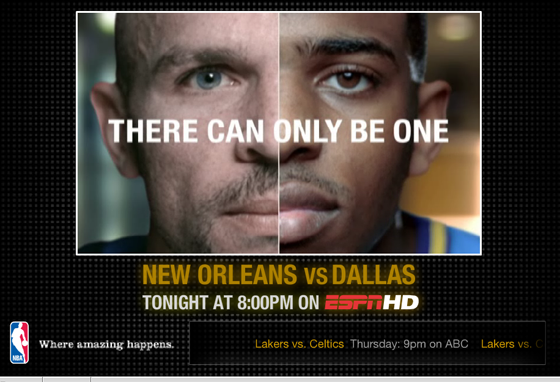
As YouTube struggles to make money on advertising, according to a story today in the Wall Street Journal, and reportedly may resort to pre-roll ads (which consumers hate, but advertisers love), maybe they should take a look at some of the innovative ad units coming out of VideoEgg. Today, VideoEgg is launching five new kinds of Web video ads. They are called:
* LIVE: Use real-time RSS feeds to continually update the ad experience
* LOCAL: Deliver zip code-specific messaging
* RICH: Easily deploy and track a rich multi-video ad experience to increase user interactivity
* SHOP: Bring the browser to the user, merchandising multiple items in a single real-time ad experience
* SHARE: Viral capabilities help spread the message through virtually any communication or social channel
The LIVE lets advertisers update the text or images via RSS feeds. In the image from the NBA ad above, the ticker at the bottom and the player’s faces change depending on what games are coming up. The LOCAL ads let advertisers ad a map button, so a Subaru ad could bring up a map of local Subauru dealers. The RICH ads offer different tabbed widgets at the bottom of the ads for different versions of the ad or to more information. The SHOP ads provide deep links to the advertiser’s online store where people can buy the DVD or cell phone being advertised. And the SHARE ads can be grabbed and spread virally on people’s blogs, MySpace and Facebook pages. You can see examples of all these ads here
All of these ad units are designed to increase viewer engagement, and in fact VideoEgg only charges advertisers if viewers engage with the ads in some way. Otherwise they are free. They call it a cost-per-engagement (CPE) model, as opposed to cost-per-thousand views (CPC) or cost-per-click (CPC).
YouTube could learn from these efforts. It is having such a hard time selling ads that it will fall short of expectations, according to the WSJ. Falling short, for YouTube, means revenues of about $200 million this year. The days of building market dominance at the expense of revenues appears to be over, with Google sales chief Tim Armstrong spearheading an effort dubbed “Project Spaghetti” to fix the “105 problems with YouTube’s ad sales,” reports the WSJ.
It looks like Citi analyst Mark Mahaney’s $500 million estimate for YouTube revenues in 2009 is going to be hard to reach. One way to quickly get there, though, would be to put pre-roll and post-roll video ads on the estimated 4 percent of videos that are advertiser-friendly (i.e. are not inappropriate or copyright-infringing—YouTube can’t plaster regular display ads on most of its pages for the same reason).
With more than one billion clips viewed per day, that 4 percent is big enough to generate some serious cash. But pre-rolls and post-rolls (10-second to 30-second video ads before and after each clip) kill the Web video watching experience. They interrupt the flow of watching videos online, which is controlled by the user. The types of video ad units that VideoEgg is experimenting with are more along the lines of what YouTube should be doing. Just as advertisers only pay if someone clicks on one of its search ads, they should only have to pay if someone chooses to engage with a video ad.
The types of ads VideoEgg is releasing may or may not be the right answer, but they are a step in the right direction. YouTube could make those types of ad units the industry standard by its sheer dominance. But if it caves and starts putting up pre-rolls and post-rolls, then these new forms of advertising might die on the vine.